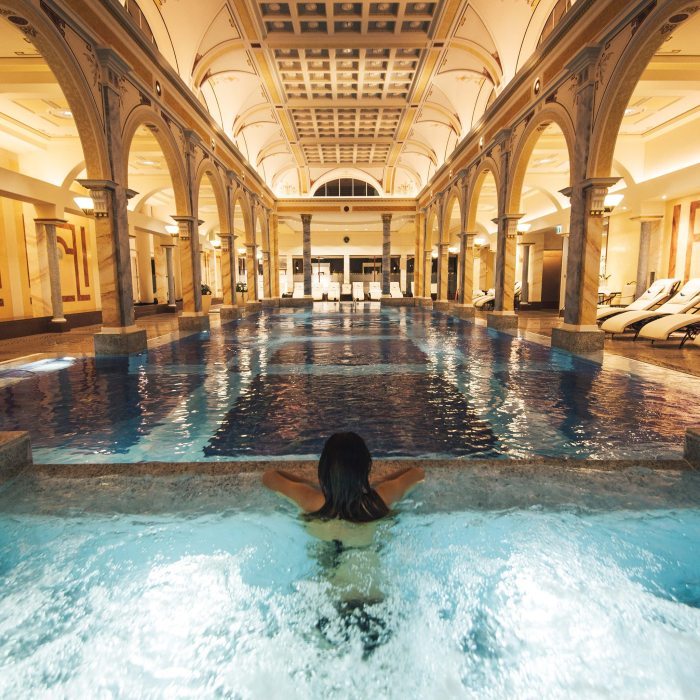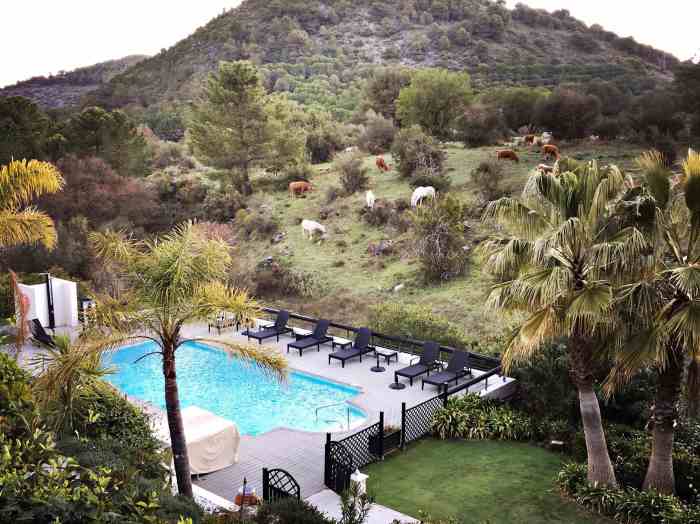
Wellness and Spa Retreats in Europe offer a diverse range of experiences, from rejuvenating yoga retreats nestled in the Tuscan countryside to luxurious detox programs on secluded Mediterranean islands. This exploration delves into the top destinations, unique treatments, and sustainable practices shaping the European wellness landscape, highlighting the luxurious amenities and bespoke experiences available to discerning travelers seeking tranquility and rejuvenation.
Whether you envision a meditative escape in the serene mountains of Austria or a revitalizing spa journey amidst the picturesque vineyards of France, Europe caters to a spectrum of wellness preferences. We will uncover the best locations, compare costs, and explore the diverse types of retreats on offer, from yoga and meditation to holistic detox programs, all while considering the increasing importance of sustainability and ethical practices within the industry.
Top Wellness and Spa Retreat Destinations in Europe

Europe boasts a rich tapestry of wellness traditions, from the thermal baths of Hungary to the holistic practices of the Baltics. The continent offers a diverse range of retreats catering to every taste and budget, making it a prime destination for those seeking rejuvenation and self-improvement. This section will explore some of the most popular destinations and the unique wellness experiences they provide.
Five Popular European Countries for Wellness Retreats, Wellness and Spa Retreats in Europe
Several European countries consistently rank highly as preferred destinations for wellness retreats. Their popularity stems from a combination of factors, including readily available natural resources, established wellness traditions, and a commitment to high-quality service.
These five countries exemplify the diverse wellness offerings across Europe:
- Austria: Known for its stunning Alpine scenery and numerous thermal springs, Austria offers retreats focused on hiking, detox, and traditional spa treatments. Many retreats incorporate elements of Kneipp therapy, a hydrotherapy system emphasizing cold and warm water applications.
- Hungary: Hungary’s thermal springs are world-renowned, with numerous spas offering treatments based on the healing properties of the mineral-rich waters. Retreats here often combine thermal bathing with traditional Hungarian massages and other wellness therapies.
- Greece: The Mediterranean climate and emphasis on healthy living make Greece an idyllic wellness destination. Retreats frequently incorporate yoga, meditation, and healthy eating, often taking advantage of the beautiful beaches and stunning landscapes.
- Portugal: With its sun-drenched coastline and tranquil countryside, Portugal offers a blend of relaxation and activity-based retreats. Many retreats incorporate surfing, hiking, and spa treatments, focusing on holistic wellbeing and mindfulness.
- Switzerland: Switzerland’s majestic mountains and pristine natural environment provide the perfect backdrop for wellness retreats. Many retreats here focus on detox, fitness, and relaxation, often incorporating elements of Swiss herbal medicine and traditional therapies.
Comparison of Spa Treatments Across European Countries
Spa treatments vary significantly across Europe, reflecting the unique cultural and historical influences of each region.
Here’s a comparison of spa treatments in three countries:
- Austria: Austrian spas often emphasize hydrotherapy, using thermal springs and other water-based treatments. Traditional herbal remedies and massages are also common. A signature treatment might involve a Kneipp-based hydrotherapy session followed by an aromatherapy massage using locally sourced herbs.
- Hungary: Hungarian spas are renowned for their thermal baths and mud treatments. The mineral-rich mud is believed to have therapeutic properties, and many treatments incorporate it into body wraps and facials. Traditional Hungarian massages, often incorporating elements of aromatherapy, are also popular.
- Greece: Greek spas often focus on holistic wellbeing, incorporating yoga, meditation, and healthy eating into their treatments. Traditional Greek massage techniques, often incorporating essential oils from local herbs and plants, are also common. Seawater treatments and thalassotherapy (sea-based therapies) are also prevalent, leveraging the healing properties of the sea.
Average Cost of Wellness Retreats in Different European Regions
The cost of a wellness retreat in Europe can vary greatly depending on the location, duration, and level of luxury.
The following table provides a general overview of average costs:
| Location | Average Price per Night | Included Services | Overall Rating (out of 5) |
|---|---|---|---|
| Austrian Alps | €150-€300 | Accommodation, meals, daily spa treatments, fitness classes | 4.5 |
| Hungarian Thermal Baths | €100-€250 | Accommodation, access to thermal baths, some treatments | 4 |
| Greek Islands | €120-€280 | Accommodation, meals, yoga classes, some spa treatments | 4.2 |
| Swiss Alps | €250-€500+ | Luxury accommodation, extensive spa treatments, fitness programs, gourmet meals | 4.8 |
Types of Wellness and Spa Retreat Experiences
Europe offers a diverse range of wellness retreats catering to various needs and preferences. From invigorating physical activities to profound inner reflection, these retreats provide opportunities for personal growth, stress reduction, and improved overall well-being. The choice depends largely on individual goals and desired level of intensity.
Yoga and Meditation Retreats
Yoga and meditation retreats combine physical postures, breathing techniques, and mindfulness practices to promote physical and mental well-being. These retreats are ideal for individuals seeking stress reduction, improved flexibility, increased mindfulness, and a deeper connection with their inner selves. Participants often experience reduced anxiety and improved sleep quality. The target audience includes individuals seeking stress relief, spiritual growth, or improved physical fitness.
Detox Retreats
Detox retreats focus on cleansing the body of toxins through dietary changes, herbal remedies, and other therapeutic practices. These programs often involve a strict diet, limiting processed foods, sugar, and alcohol, while emphasizing fresh fruits, vegetables, and whole grains. Other practices might include colonics, lymphatic drainage massages, and sweating therapies. The benefits include improved digestion, increased energy levels, clearer skin, and a renewed sense of vitality.
The target audience typically includes individuals seeking to improve their health, lose weight, or address specific health concerns, such as digestive issues.
Fitness and Adventure Retreats
These retreats combine physical activity with the benefits of a relaxing spa environment. Activities may include hiking, cycling, water sports, rock climbing, or other adventurous pursuits, followed by rejuvenating spa treatments. This type of retreat appeals to individuals who prefer an active approach to wellness and enjoy exploring new environments. The target audience is typically active individuals seeking a challenging yet rewarding experience that combines physical exertion with relaxation and pampering.
Ayurvedic Retreats
Ayurvedic retreats integrate traditional Indian medicine principles to restore balance and harmony within the body and mind. These retreats often involve personalized consultations, dietary recommendations, herbal treatments, and massage therapies tailored to an individual’s unique constitution (dosha). Benefits include improved digestion, reduced stress, and enhanced overall well-being. The target audience is generally those seeking a holistic approach to wellness and a deeper understanding of their body’s natural rhythms.
Sample Seven-Day Yoga and Meditation Retreat Itinerary: Tuscany, Italy
This itinerary provides a framework for a transformative week in the heart of Tuscany.
| Day | Morning | Afternoon | Evening |
|---|---|---|---|
| 1 | Arrival and welcome; introductory yoga session | Guided Tuscan countryside walk; free time | Opening circle; welcome dinner |
| 2 | Hatha yoga; meditation | Cooking class focusing on Tuscan cuisine | Restorative yoga; sound healing |
| 3 | Vinyasa yoga; pranayama | Free time for exploration of local town/village | Meditation; journaling |
| 4 | Yin yoga; guided meditation | Wine tasting at a local vineyard | Yoga nidra; sharing circle |
| 5 | Ashtanga yoga; mindfulness walk | Massage therapy; free time for relaxation | Kirtan; candlelit meditation |
| 6 | Restorative yoga; meditation | Visit to a local spa; optional treatments | Closing circle; farewell dinner |
| 7 | Final yoga session; departure |
Luxury Amenities and Services at European Wellness Retreats: Wellness And Spa Retreats In Europe

High-end European wellness retreats go beyond simply offering spa treatments; they curate holistic experiences designed to rejuvenate the mind, body, and spirit. These retreats provide a level of luxury and personalized service that transforms a wellness break into an unforgettable escape. The emphasis is on creating an environment of unparalleled comfort and bespoke experiences, catering to individual needs and preferences.The range of luxury amenities available at these retreats is extensive.
Imagine waking up in a private villa with breathtaking views, perhaps overlooking the Mediterranean Sea or nestled amidst rolling Tuscan hills. Many retreats offer personalized fitness programs tailored to individual goals, guided by expert trainers. Gourmet dining experiences, featuring locally sourced, organic ingredients prepared by Michelin-starred chefs, are a standard feature. Beyond the physical, many retreats incorporate mindfulness practices, yoga sessions, and meditation retreats to enhance the overall wellness journey.
Access to private pools, steam rooms, and saunas within the villas or as part of the retreat’s facilities adds another layer of indulgence.
Unique and Innovative Spa Treatments at European Wellness Retreats
European wellness retreats are known for their innovative and unique spa treatments, often incorporating traditional techniques with modern advancements. Hydrotherapy treatments, utilizing the healing properties of water, are prevalent, ranging from thalassotherapy (using seawater) to thermal spring baths. Ayurvedic treatments, rooted in ancient Indian medicine, are also popular, incorporating massage, herbal remedies, and dietary adjustments. Some retreats offer unique treatments such as wine therapy, using grape extracts for skincare, or chocolate therapy, utilizing cocoa for its antioxidant and mood-boosting properties.
Advanced techniques like cryotherapy (exposure to extremely cold temperatures) and oxygen therapy are also becoming increasingly popular, promising a range of benefits from pain relief to improved athletic performance. These unique offerings are often combined with personalized consultations to create a truly bespoke spa experience.
Top Five Most Luxurious Wellness Retreats in Europe
The selection of the most luxurious retreats is subjective and depends on individual preferences. However, considering reputation, amenities, and guest experiences, the following five retreats consistently rank among the top:
- Sha Wellness Clinic, Alicante, Spain: Known for its holistic approach to wellness, Sha Wellness Clinic combines cutting-edge medical treatments with traditional therapies. Their signature services include personalized detox programs, anti-aging treatments, and a range of innovative therapies. The stunning cliffside location and luxurious accommodations add to the overall experience.
- The Farm at Carneros, Napa Valley, California (USA – close proximity to Europe): While technically in the USA, its close proximity and European-style luxury make it a worthy mention. Focuses on farm-to-table dining and luxurious accommodations. Signature services include wine tasting and farm activities alongside wellness treatments.
- Lanserhof Lans, Austria: This retreat is renowned for its medical wellness programs, focusing on detoxification and preventative health. Signature services include fasting cures, hydrotherapy treatments, and innovative medical therapies. The stunning alpine setting provides a tranquil backdrop for the healing journey.
- Palazzo Fiuggi, Italy: A luxurious spa hotel with a strong focus on medical wellness. Signature services include thermal spring treatments, advanced medical diagnostics, and personalized weight management programs. The historic palazzo setting adds a touch of grandeur to the experience.
- The Chenot Palace Weggis, Switzerland: Situated on the shores of Lake Lucerne, this retreat is famous for its exclusive Chenot method, which combines nutrition, exercise, and spa treatments to promote cellular regeneration. Signature services include detox programs, hydrotherapy, and advanced cellular rejuvenation treatments. The stunning lakeside location provides a truly idyllic setting.
Sustainability and Ethical Practices in European Wellness Retreats
The European wellness retreat sector is experiencing a significant shift towards eco-conscious and ethical operations. Driven by increasing consumer awareness and a growing demand for responsible travel, many retreats are actively incorporating sustainable practices into their business models, aiming to minimize their environmental footprint and maximize their positive social impact. This commitment extends beyond simple greenwashing, with many retreats implementing tangible changes across various aspects of their operations.The integration of sustainability is not merely a trend but a crucial aspect of the future of wellness tourism in Europe.
Consumers are increasingly discerning, seeking out retreats that align with their values and contribute to a healthier planet. This growing demand is pushing retreats to innovate and implement robust sustainability initiatives, creating a more responsible and rewarding experience for both guests and the local communities.
Examples of Eco-Friendly and Sustainable European Wellness Retreats
Several European wellness retreats serve as exemplary models for environmentally responsible and socially conscious operations. These retreats demonstrate that luxury and sustainability can coexist, creating a truly holistic and transformative experience. Their initiatives range from energy efficiency and waste reduction to supporting local communities and preserving biodiversity. The commitment to sustainability is often deeply embedded in the retreat’s philosophy and operations, impacting everything from sourcing ingredients to staff training.
Comparing Sustainability Initiatives of Three European Wellness Retreats
To illustrate the diversity of approaches to sustainability, let’s examine three distinct retreats. While specifics vary, common themes of energy conservation, waste management, and community engagement emerge.
- Retreat A (Hypothetical Example: The Alpine Sanctuary, Austria): This retreat, nestled in the Austrian Alps, focuses on minimizing its carbon footprint through the use of renewable energy sources (solar and hydropower), locally sourced organic food, and sustainable building materials in its construction. They actively engage in reforestation projects in the surrounding area and support local farmers and artisans. Their waste management system prioritizes reduction, reuse, and recycling, minimizing landfill waste.
- Retreat B (Hypothetical Example: The Coastal Haven, Portugal): Located on the Algarve coast, this retreat emphasizes water conservation through rainwater harvesting and efficient irrigation systems. They partner with local fishermen to source seafood sustainably and minimize plastic use throughout the resort. Their commitment to biodiversity is evident in their preservation of natural habitats and support for local conservation efforts. Staff training focuses on responsible tourism practices and environmental awareness.
- Retreat C (Hypothetical Example: The Tuscan Escape, Italy): This Tuscan retreat prioritizes organic farming and utilizes its own gardens to provide fresh produce for its restaurant. They support local producers and artisans, fostering economic development in the region. Their energy efficiency measures include the use of energy-saving appliances and the implementation of a comprehensive recycling program. They also offset their carbon emissions through investment in renewable energy projects.
These examples highlight the diverse ways in which European wellness retreats are integrating sustainability into their operations. While each retreat has its unique approach, the common thread is a genuine commitment to environmental responsibility and social impact. This commitment is not only ethically sound but also enhances the overall guest experience, creating a more meaningful and enriching retreat.
Ultimately, the allure of European wellness retreats lies in their ability to seamlessly blend luxurious indulgence with transformative experiences. From the soothing sounds of the ocean to the invigorating scents of essential oils, each retreat offers a personalized journey towards holistic well-being. By carefully considering your preferences and exploring the diverse options available, you can curate a bespoke wellness escape that leaves you feeling refreshed, rejuvenated, and deeply connected to yourself and the stunning landscapes of Europe.
FAQ Compilation
What is the best time of year to visit European spa retreats?
The ideal time depends on your preferences and the specific location. Shoulder seasons (spring and autumn) often offer pleasant weather and fewer crowds.
How do I choose the right type of wellness retreat for me?
Consider your goals (detox, stress reduction, relaxation, etc.) and preferred activities (yoga, hiking, meditation). Research different retreat types and read reviews.
What should I pack for a European wellness retreat?
Pack comfortable clothing, swimwear, toiletries, and any personal items you need for your chosen activities. Check the retreat’s recommendations for specific items.
Are there any language barriers to consider?
While English is widely spoken in many tourist areas, learning a few basic phrases in the local language can enhance your experience. Many retreats offer multilingual staff.


